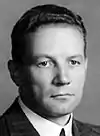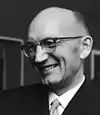Kekkonen's First Cabinet | |
|---|---|
33rd Cabinet of Finland | |
 Group picture of Kekkonen's first government March 18, 1950 at the President's palace. | |
| Date formed | 17 March 1950 |
| Date dissolved | 17 January 1951 |
| People and organisations | |
| President | Juho Kusti Paasikivi |
| Prime Minister | Urho Kekkonen |
| No. of ministers | 11 |
| Total no. of members | 19 |
| Member parties | Agrarian League National Progressive Party Swedish People's Party |
| Status in legislature | Minority 74 / 200 (37%)
|
| Opposition parties | |
| History | |
| Predecessor | Fagerholm I Cabinet |
| Successor | Kekkonen II Cabinet |
Kekkonen's first cabinet was the 33rd government of Finland. The cabinet existed from 17 March 1950 to 17 January 1951. It was a minority government. The cabinet's Prime Minister was Urho Kekkonen.[1]
During the cabinet's run, Kekkonen took a more significant role in the management of Soviet relations than president Paasikivi. For example, as Prime Minister, Kekkonen signed the Soviet-sponsored World Peace Council act banning atomic weapons. In June 1950, Kekkonen travelled to Moscow to agree on the first five-year agreement between Finnish-Soviet trade. The cabinet's foreign policy lead to an improvement in Finnish-Soviet relationships.
One of the cabinet's problems was the large inflation caused by the Korean War.
Ministers
- Key
- RES Resigned
References
- ↑ "Composition of a certain government, 33. Kekkonen". Valtioneuvosto. Archived from the original on 11 June 2022. Retrieved 11 June 2022.
This article is issued from Wikipedia. The text is licensed under Creative Commons - Attribution - Sharealike. Additional terms may apply for the media files.





.jpg.webp)


.jpg.webp)
.jpg.webp)



.jpg.webp)

